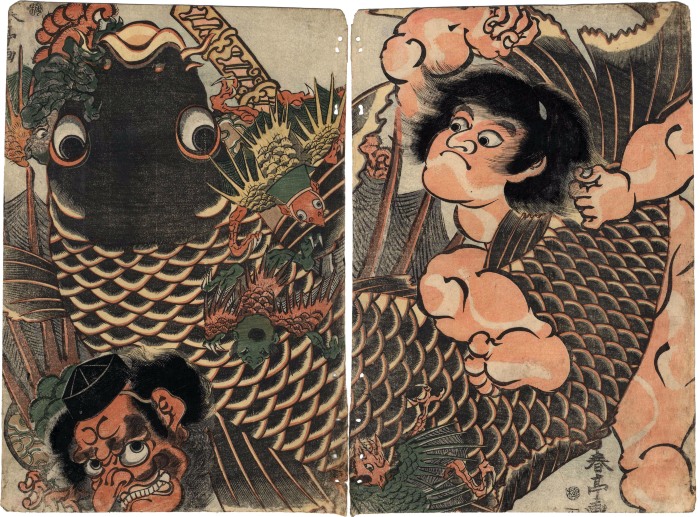Katsukawa Shuntei (勝川春亭) (artist 1770 – 1820)
Kintarō (金太郎), carp and tengu diptych
ca 1810
18.5 in x 13.5 in (Overall dimensions) Japanese color woodblock print.
Signed: Shuntei ga (春亭画)
Publisher: Murataya Jirōbei
(Marks 359 - seal 08-098)
Censor's seal: kiwame
Lyon Collection example of left sheet
Waseda University Library - one volume of Itogoromo tengu haikai Kintarō struggling with a giant carp while being aided by a group of tengu.
****
The tengu are mythical dwellers of the forests and divided into two classes: the ordinary human-shaped 'konoha tengu' with wings and a nose of inordinate length, and the bird-like tengu with a strong beak called karasu tengu (crow tengu). Both kinds are shown in this print. Carp (koi) are often represented leaping a waterfall and harken back to the Chinese story of a sturgeon of the Hang-Ho which, having swam up the river and crossed the rapids of Lung Men (Dragon Gate), became a dragon itself. At boy's birthday festival on the fifth day of the fifth month carp shaped kites are floated over housetops in Japan to encourage boys to rise to fame and fortune.
****
There is an ehon illustrated by Shuntei and written by Nakamura Utaemon III that is filled with fantastic characters, including tengu. The title is 'Itogoromo tengu haikai' (糸衣天狗俳諧) and it is said to have appeared in 6 volumes in 1815. One volume is illustrated online at the Waseda University Library. Click on the link we have added.
****
The cap or tokin (兜巾) that the tengu king is wearing
Q. E. Phillips wrote about the warriors, disguised as yamabushi, who killed the monster Shuten Doji:
"Likewise, their vanquishing of the demons coincides with the exorcistic healing practices of yamabushi. Most tellingly, when the men have dressed for battle, only Raikō dons a helmet; every other warrior keeps on his tokin 兜巾... the cap which is one of the most distinctive elements of the mountain ascetic’s apparel, representing a lotus- cap or the head protuberance apparent on representations of the Buddha. The tokin also functions as a protective item for monks practicing mountain rituals. To the viewer who understands the yamabushi garb merely as a disguise, this pictorial element makes no sense: a samurai helmet would afford better protection from physical harm, as it does in the Itsuō version. The clear implication is that the battle ahead is not merely physical, but has some elements of an exorcism, for which the men require mystical protection. They are, on some level, clearly to be understood as yamabushi."
Andrea K. Gill at the University of Tennessee in Knoxville wrote in 2012 in an undergraduate paper which adds breadth to our understanding of this ritual cap:
"Tokin (頭襟): A small black hat that wards off poisonous vapors. It is made with twelve folds to symbolize the Buddhist twelve-fold chain of causation."
Yūrei-zu (幽霊図 - ghosts demons monsters and spirits) (genre)
Murataya Jirōbei (村田屋治郎兵衛) (publisher)
Tengu (天狗) (genre)
Kintarō (金太郎) (role)
